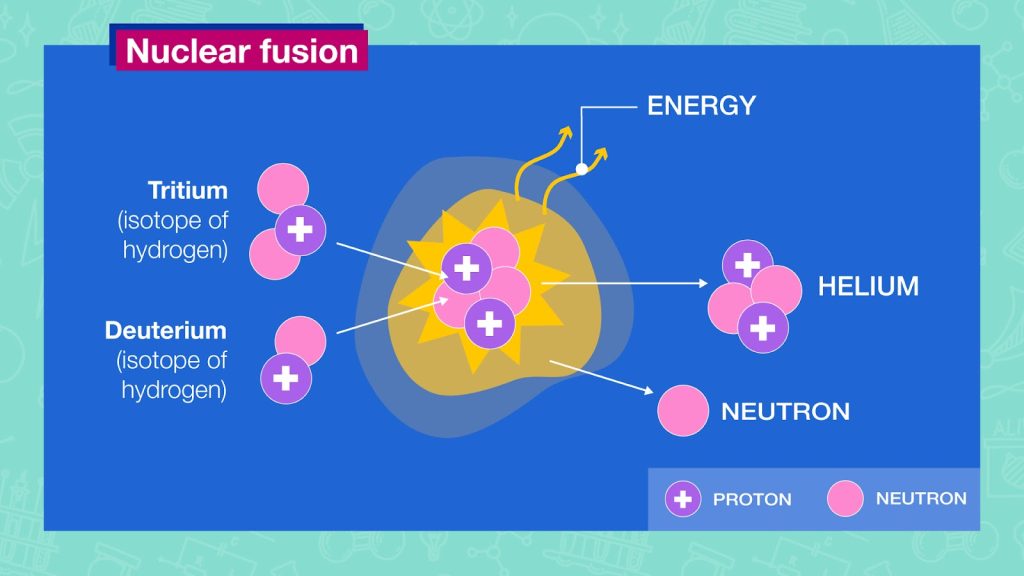What Is the Carbon Footprint of Nuclear Fusion? A Life-Cycle Assessment
Affiliate Disclosure
Hey fellow impactful ninja ?
You may have noticed that Impactful Ninja is all about providing helpful information to make a positive impact on the world and society. And that we love to link back to where we found all the information for each of our posts.
Most of these links are informational-based for you to check out their primary sources with one click.
But some of these links are so-called "affiliate links" to products that we recommend.
Why do we add these product links?
First and foremost, because we believe that they add value to you. For example, when we wrote a post about the environmental impact of long showers, we came across an EPA recommendation to use WaterSense showerheads. So we linked to where you can find them. Or, for many of our posts, we also link to our favorite books on that topic so that you can get a much more holistic overview than one single blog post could provide.
And when there is an affiliate program for these products, we sign up for it. For example, as Amazon Associates, we earn from qualifying purchases.
What do these affiliate links mean for you?
First, and most importantly, we still only recommend products that we believe add value for you.
When you buy something through one of our affiliate links, we may earn a small commission - but at no additional costs to you.
And when you buy something through a link that is not an affiliate link, we won’t receive any commission but we’ll still be happy to have helped you.
What do these affiliate links mean for us?
When we find products that we believe add value to you and the seller has an affiliate program, we sign up for it.
When you buy something through one of our affiliate links, we may earn a small commission (at no extra costs to you).
And at this point in time, all money is reinvested in sharing the most helpful content with you. This includes all operating costs for running this site and the content creation itself.
What does this mean for me personally?
You may have noticed by the way Impactful Ninja is operated that money is not the driving factor behind it. It is a passion project of mine and I love to share helpful information with you to make a positive impact on the world and society. However, it's a project in that I invest a lot of time and also quite some money.
Eventually, my dream is to one day turn this passion project into my full-time job and provide even more helpful information. But that's still a long time to go.
Stay impactful,
On a per-mass basis, nuclear fusion can generate four times as much energy as nuclear fission while producing very little carbon dioxide (CO2) or radioactive byproducts. So, we had to ask: What is the carbon footprint of nuclear fusion?
Nuclear fusion produces little to no greenhouse gas emissions or toxic byproducts. Although nuclear fusion experiments are relatively easy to achieve, it is difficult to maintain the fusion reaction; nuclear fusion is still being researched and does not yet supply energy to our power grid.
Keep reading to learn about the overall carbon footprint of nuclear fusion and its carbon footprint throughout its life cycle.
How is Nuclear Fusion Defined
Nuclear fusion is the process by which lighter atoms are combined or fused to create larger and heavier atoms. It is one of two ways to produce nuclear energy.
“Nuclear fusion: the process of joining two nuclei to produce energy.”
Cambridge Dictionary
Nuclear fusion reactions take place inside fusion reactors inside plasma, a hot, charged gas made of positive ions and free-moving electrons. Deuterium and tritium, isotopes of hydrogen with extra neutrons, are the most commonly used nuclear fusion materials.

Nuclear fusion is still very much in the research and development phase. The sun and stars get their energy from nuclear fusion, as hydrogen atoms fuse to form helium and matter converts into energy.
What is the Carbon Footprint of Nuclear Fusion
The carbon footprint is one of the ways we measure the effects of human-induced global climate change. It primarily focuses on the greenhouse gas (GHG) emissions associated with consumption and includes other emissions such as methane (CH4), nitrous oxide, and chlorofluorocarbons (CFCs).
“Carbon footprint: the amount of greenhouse gasses and specifically carbon dioxide emitted by something (such as a person’s activities or a product’s manufacture and transport) during a given period”
Merriam Webster
Basically, it is the amount of carbon emitted by an activity or an organization. This includes GHG emissions from fuel that we burn directly (e.g., heating a home or driving a car) and GHG emissions from manufacturing the products that we use (e.g., power plants, factories, and landfills).
What Is the Overall Carbon Footprint of Nuclear Fusion
Nuclear fusion produces little to no greenhouse gas emissions and toxic byproducts, making it one of our most environmentally friendly energy sources. One study on tokamak fusion power plants found that they emit less CO2 than photovoltaic solar systems and less than half those from nuclear fission reactors.
In terms of installed capacity, there are currently more than 10 stellarators and 50 tokamaks in operation worldwide, but there are currently no operating reactors that provide energy to our power grid. The focus remains on overcoming the two main challenges to nuclear fusion: keeping the reaction going and generating more energy from the reaction than was required to start the reaction.
To understand the carbon footprint of nuclear fusion, we must assess its life cycle and each stage’s carbon footprint. This life-cycle assessment (LCA) is a method to evaluate the environmental impacts of products and materials. Over the years, companies have strategically used LCA to research and create more sustainable products. So, let’s have a look at the LCA of nuclear fusion!
| The life-cycle stages of nuclear fusion | Each stage’s carbon footprint |
| Building of nuclear fusion | Some CO2 emissions from constructing the nuclear fusion power plant and reactor |
| Operating of nuclear fusion | Little to no CO2 emissions or waste products |
| Building back of nuclear fusion | Some CO2 emissions from deconstructing the power plant and reactor |
The total carbon footprint of nuclear fusion would equal the carbon footprint from building + the carbon footprint from operating + the carbon footprint from building back.
What Is the Carbon Footprint of Building Nuclear Fusion
The carbon footprint of building nuclear fusion includes constructing the power plant and the nuclear fusion reactor.
Nuclear fusion reactors can consist of millions of components including, but not limited to, magnets, coils, antennas, diagnostic instruments, cryopumps, thermal shields, and beam injectors, all of which have a carbon footprint of their own.
For example, the world’s largest tokamak, named ITER, is currently being built in France. Consisting of over a million components and weighing 23,000 tons, the machine will be able to maintain a temperature 10x that of the sun’s core and will have a 500 megawatt (MW) fusion energy output power once constructed.
What Is the Carbon Footprint of Operating Nuclear Fusion
Nuclear fusion reactors do not produce any CO2 emissions in the operating phase because there is no burning of fossil fuels or combustion byproducts.
Nuclear fusion power plants generally operate in the following manner:
- Deuterium (D) and Tritium (T) (isotopes of hydrogen) are introduced into a fusion reactor and heated upwards of 150 million degrees Celsius
- The deuterium and tritium fuse together, forming an electrically charged gas known as plasma and releasing massive amounts of energy and neutrons
- A lithium blanket surrounding the core of the fusion reactor absorbs the kinetic energy of the neutrons, causing the blanket to heat up
- As the blanket heats up, the lithium is transformed into tritium (which is used to fuel the reaction) and helium
- The energy, in the form of heat, is collected by the coolant (water, helium, or Li-Pb eutectic) flowing through the blanket
- The heat can be used to generate electricity
The two most common fusion reactors in use today are tokamaks and stellarators. Both use magnetic fields to confine plasma in the shape of a donut.
- Tokamaks: Induce electric currents inside of the plasma. Tokamaks are easier to build than stellarators and are better at keeping plasmas hot. They are the preferred option today for nuclear fusion energy power plants.
- Stellarators: Use external coils to generate a twisting magnetic field. They require less injected power, have greater design flexibility, and are better at keeping plasma stable than tokamaks. However, they are also more complex to build.
What Is the Carbon Footprint of Building Back Nuclear Fusion
The fuel for fusion reactions, deuterium and tritium, are easily accessible. Deuterium can be extracted from seawater, and tritium can be produced inside tokamak reactors when plasma comes into contact with the lithium blanket. Because the fuel is virtually inexhaustible, this means nuclear fusion reactions could always be generated (under the right conditions).
Because nuclear fusion has not yet achieved commercial viability, there is no data involving the decommissioning of nuclear fusion reactors or power plants. As a comparison, nuclear fission power plants have an average life expectancy of 40-60 years.
What Role Does Nuclear Fusion Play in Combating Climate Change
Climate change is arguably the most severe, long-term, global impact of fossil fuel combustion. Every year, approximately 33 billion tons (bt) of CO2 are emitted from burning fossil fuels. The carbon found in fossil fuels reacts with oxygen in the air to produce CO2. This warms the earth by acting as a heating blanket, and a warmer earth comes with a host of negative side effects.
Using nuclear fusion to produce energy instead of fossil fuel energy helps mitigate the following negative effects of climate change:
- Increasing temperatures: Earth’s atmosphere has warmed 1.5°C since 1880. This may not seem like a lot, but these degrees create regional and seasonal temperature extremes, reduce sea ice, intensify rainfall and drought severity, and change habitat ranges for plants and animals.
- Rising sea levels: Global sea levels have increased approximately 8-9 inches since 1880, displacing people living along coastlines and destroying coastal habitats. Roads, bridges, subways, water supplies, oil and gas wells, power plants, sewage treatment plants, and landfills remain at risk if sea level rise goes unchecked.
- Melting of sea ice: Since 1979, arctic sea ice has declined by 30%. Sea ice plays a major role in regulating the earth’s climate by reflecting sunlight into space and providing habitat for animal species. If all of the glaciers on Earth melted, sea levels would rise by approximately 70 feet, effectively flooding out every coastal city on the planet.
- Changing precipitation patterns: Extreme weather events (e.g., hurricanes, floods, droughts) are becoming more common and more intense. Storm-affected areas will experience increased precipitation and flooding whereas areas located further from storm tracks will experience decreased precipitation and droughts.
- Ocean acidification: The ocean absorbs 30% of the CO2 released into the atmosphere, which decreases the pH (increases the acidity) of the ocean. In the past 200 years, the pH of oceans has decreased by 0.1 pH units, which translates to a 30% increase in acidity. Aquatic life unable to adjust to this rapid acidification will die off. A prime example of this is coral bleaching, where coral expels the algae (zooxanthellae) living in their tissues as a result of changes in temperature, light, or nutrients.
The more we reduce CO2 emissions, the more we slow the rate of temperature rise, sea-level rise, ice melting, and ocean acidification. When these rates are slowed, the earth’s biodiversity does not have to struggle to adapt to temperature and pH changes. People will not be displaced due to the flooding of coastal areas. And icebergs will continue to provide climate regulation.
Most experts agree that we are unlikely to achieve large-scale nuclear fusion energy generation before 2050. This means that fusion is not an option for meeting the short-term climate goals laid out in The Paris Climate Agreement, which aims to limit global warming to below 2 degrees Celsius (C).
How Environmentally Friendly Is Nuclear Fusion
Experts tout nuclear fusion as a clean, safe, reliable, and environmentally friendly energy source.
“Environmentally friendly: (of products) not harming the environment.”
Cambridge Dictionary
Nuclear fusion can reduce the effects of global warming by limiting global emissions, and it comes with minimal negative environmental effects.
What Are The Environmental Benefits of Nuclear Fusion
Nuclear fusion has the potential to play a key role in the clean energy movement. This is because nuclear fusion:
- Has a low carbon footprint: Nuclear fusion produces little to no greenhouse gas emissions and toxic byproducts, making it one of our most environmentally-friendly sources of energy. One study on tokamak fusion power plants found that they emit less CO2 than photovoltaic solar systems and less than double those from nuclear fission reactors.
- Efficiently produces a lot of energy: In theory, it is possible to produce one terajoule of energy with just a few grams each of Deuterium and tritium. This would be enough to meet the needs of an adult person living in the developed world for 60 years. Estimates also suggest that nuclear fusion alone could generate up to 4 times more energy per kilogram of fuel than nuclear fission and nearly 4 million times more energy than burning oil or coal.
- Uses readily available materials: The fusion reaction is most readily feasible between deuterium and tritium, two isotopes of hydrogen. Deuterium is naturally abundant in seawater, and tritium can be bred from lithium, which is naturally abundant in the Earth’s crust and in seawater. Compare this to Uranium-235, the ingredient for nuclear fission, which has a concentration of only 2.8 parts per million (0.7% abundance) in the Earth’s crust.
- Does not produce long-lived nuclear waste: Unlike nuclear fission, nuclear fusion reactions do not produce long-lived nuclear waste. The only byproducts are helium (an inert gas) and tritium. Although tritium is radioactive, it is produced and consumed within the plant in a closed circuit and is only used in low amounts.
- Cannot cause a nuclear accident: Unlike nuclear fission, nuclear fusion reactions are not based on chain reactions. Plasma must be kept at very high temperatures and pressures, with the support of external heating systems and magnetic fields. If there is a loss of pressure or temperature, the reactor shuts down with no adverse effects to the outside world.
- Cannot be used to produce nuclear weapons: Hydrogen bombs do use fusion reactions; however, they require an additional nuclear fission bomb to detonate. Fusion fuel is also continuously injected and consumed in fusion reactors, so there is never enough fuel lying around to produce a weapon.
- Promotes energy security: Nuclear energy contributes to energy security by increasing the stability of our power grids. Unlike renewable energy, which faces variations in supply and demand, nuclear energy can provide a reliable and consistent source of clean energy.
What Are The Environmental Drawbacks of Nuclear Fusion
Unlike nuclear fission, nuclear fusion does not generate long-lived radioactive waste. However, experts have noted that nuclear fusion can produce short- to medium-term radioactive waste. Component materials constantly bombarded by neutrons will become radioactive over time and generate nuclear waste. The amount of waste would be comparable to waste generated by nuclear fission, but nuclear fusions’ waste is less radioactive in the long term.
In addition, tritium is weakly radioactive. If tritium were leaked into the environment, it could be difficult to contain given that it can penetrate concrete and rubber. It is also easily incorporated into water and can make water weakly radioactive. Tritium has a half-life of roughly 12 years, meaning it could persist up to 125 years after it is created.
Although tritium is radioactive, it is produced and consumed within the plant in a closed circuit and is only used in low amounts. Still, the possibility of leaks has spurred research into deuterium-deuterium fusion, because deuterium is not radioactive.
What Are Other Challenges of Nuclear Fusion
Because nuclear fusion produces zero CO2 emissions, there are very few environmental drawbacks; however, significant logistical challenges are preventing nuclear fusion from becoming a mainstream energy source.
Presently, the two main challenges to nuclear fusion are maintaining the reaction and generating more energy from the reaction than was required to start the reaction.
Nuclear fusion experiments themselves are relatively easy to achieve; however, the reaction typically only lasts a fraction of a second. The main challenge with nuclear fusion comes with sustaining fusion reactions for prolonged periods of time. To sustain a nuclear fusion reaction, hydrogen isotopes must be confined at extremely high pressures and temperatures that are several times hotter than the sun.
Hydrogen atoms on the sun can fuse at temperatures of 15 million degrees Celsius, but because Earth has weaker gravitational forces, achieving fusion requires maintaining temperatures upwards of 150 million degrees Celsius. Developing a machine to contain and maintain that amount of heat and pressure has proved difficult thus far.
In 2021, JET held a nuclear fusion reaction for 5 seconds to produce 59 megajoules (MJ) of energy, almost double that of the previous record. However, scientists had to put 3x as much energy into the system as was created by the reaction.
In December 2022, The National Ignition Facility at Lawrence Livermore National Laboratory in California (US) created a fusion reaction that produced more energy than was needed to spark the reaction. The machine’s laser fired 2 megajoules onto a target and produced 3 megajoules of energy. This demonstrated the viability of nuclear fusion energy for the first time ever.
Final Thoughts
Nuclear fusion produces little to no greenhouse gas emissions and toxic byproducts, making it one of our most environmentally friendly sources of energy.
Currently, nuclear fusion does not supply energy to our power grid. The focus remains on refining the technology and increasing investments. There are currently more than 10 stellarators and 50 tokamaks in operation worldwide, but none produce electricity.
Most experts agree that we are unlikely to achieve large-scale nuclear fusion energy generation before 2050. The future of nuclear fusion will depend on us overcoming the two main challenges to nuclear fusion: maintaining the reaction and generating more energy from the reaction than was required to start the reaction. This will require increased funding and further technological advancements.
Stay impactful,

Sources
- International Atomic Energy Agency: What is nuclear fusion
- Impactful Name: Nuclear Power Explained: All You Need to Know
- International Atomic Energy Agency: What is Nuclear Fusion?
- Britannica: Tritium
- International Atomic Energy Agency: What is Deuterium?
- International Atomic Energy Agency: Nuclear Fusion
- World Nuclear Association: Nuclear Fusion
- Britannica: Carbon Footprint
- United States Environmental Protection Agency: System of Registries
- IOPscience: Evaluation of CO2 emissions in the life cycle of tokamak fusion power reactors
- International Atomic Energy Agency: Tokamaks, Stellarators, Laser-based and Alternative Concepts: Report Offers Global Perspective on Nuclear Fusion Devices
- Science Direct: Life-cycle assessment (LCA)
- MIT SMR: Strategic Sustainability Uses of Life-Cycle Analysis
- European Joint Undertaking for ITER and the Development of Fusion Energy: ITER Tokamak Fusion Reactor
- ITER: Machine
- International Atomic Energy Agency: Magnetic Fusion Confinement with Tokamaks and Stellarators
- US Department of Energy: DOE Explains…Stellarators
- ITER: Tritium Breeding
- World Nuclear Association: Decommissioning nuclear facilities
- National Wildlife Federation: Climate Change
- National Oceanic and Atmospheric Administration: Climate Change: Global Temperature
- National Oceanic and Atmospheric Administration: Climate Change: Global Sea Level
- United States Geological Survey: How would sea level change if all glaciers melted?
- The National Aeronautics and Space Administration: How does climate change affect precipitation?
- National Oceanic and Atmospheric Administration: Ocean acidification
- Scientific American: What is the future of fusion energy?
- United Nations Framework Convention on Climate Change: The Paris Agreement
- International Atomic Energy Agency: Fusion – Frequently asked questions
- World Nuclear Association: Uranium Mining Overview
- International Energy Agency: Nuclear
- Canadian Nuclear Safety Commission: Facts about tritium
- Lawrence Livermore National Laboratory: The Age of Ignition – Inside LLNL’s Fusion Breakthrough
- Science: European fusion reactor sets record for sustained energy




